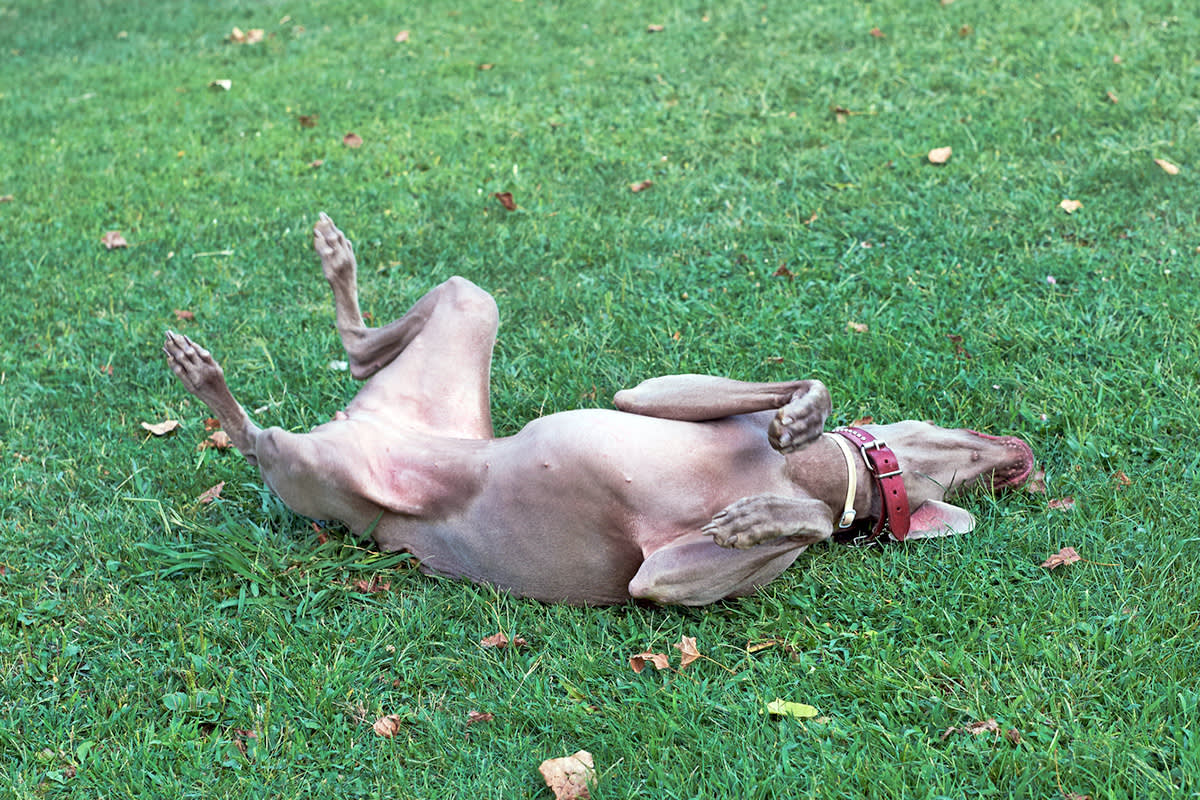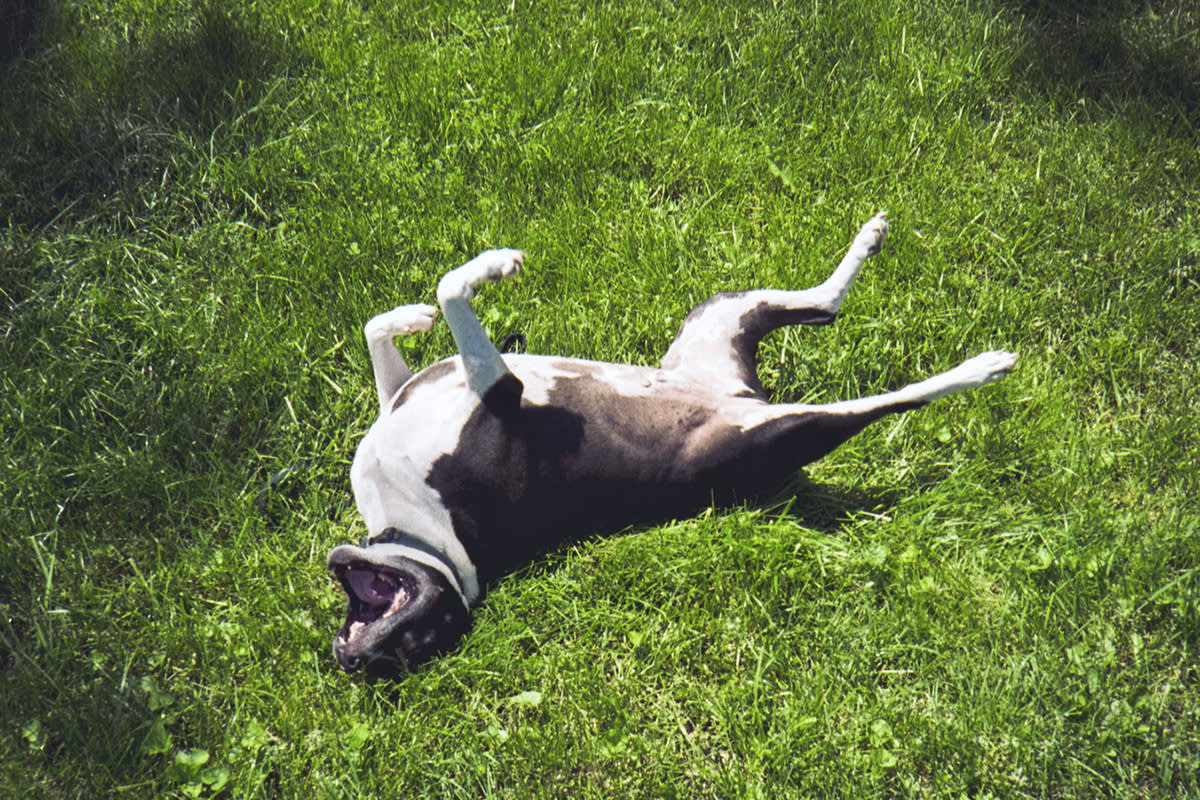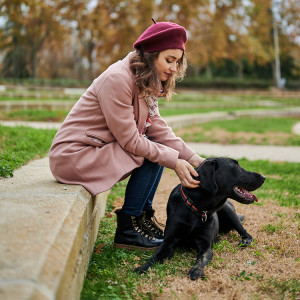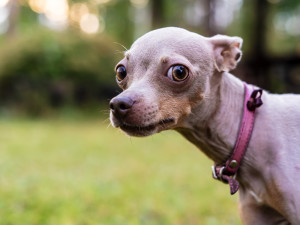Do Dogs Really Do a “Contentment Ceremony” When They’re Happy?
The internet thinks so.

Share Article
If you’ve spent time on “PetTok” or other social media recently, you’ve probably seen videosopens in new tab from pet parents claiming to show their dog’s “contentment ceremony.” This often involves a pup rolling around on their back, legs flailing in the air (with their bits out and open to the wind) or rubbing their face in blankets or grass. These videos claim these little rituals are a dog’s way of saying thank you or expressing happiness after a meal or positive experience.
We know that dogs heavily rely on body language to communicate. But are contentment ceremonies really a scientifically backed phenomenon?
Are contentment ceremonies a real thing?
Certified dog trainer Sassafrass Patterdale says that while contentment ceremonies haven’t necessarily been proven by scientific studies, they are a real thing. When a dog is doing one of these silly little rituals, their body language is open and relaxed, which are signs that they are happy, comfortable, safe. “These behaviors are a great sign that your dog isn’t stressed and is feeling relaxed in the home,” says Patterdale.
That is the most-likely scenario, anyway. Sometimes, though, it could also mean that they are just doing something practical, like relieving an itchy back or face. Or maybe they are rolling in something smelly in the yard, an evolutionary behavior to mask their own scent.

There’s also a chance that these repeated behaviors may be a product of good old positive reinforcement. For example, if you notice your dog rolling around in a truly adorable manner after a meal and react positively (like with high -pitched praise), they will be more likely to repeat what they’re doing. Anything to get a delighted squeal out of their person, right?
“Such behaviors can be downright endearing and make us feel good as well,” veterinary behaviorist Deborah Bryant adds. “Communication is a two-way street!”
Is it OK to encourage a contentment ceremony ritual?
Having a little ritual to share with your pet is just plain cute. Maybe you make that gleeful noise, which sends them into a merry fit on the floor or in the grass. So, is there any harm in using positive reinforcement to create a contentment ceremony with your dog?
Bryant says building strong communication with our pets does have the potential to strengthen our relationship with them. However, approach any high-energy behavior with caution — especially after dinnertime. Riling dogs up right after a meal could lead to digestive issues or even bloat.
“Follow the old adage of ‘rest and digest’ after your dog’s meal, with the exception of some brief behaviors of ‘feeling good,’” Bryant advises.
Also, keep an eye out for unusual post-meal behaviors or body language that might indicate your dog is actually feeling discomfort. Signs like lip-smacking, “hard” swallowing or gulping, excess burping, staring into space, or upward “tucking” of their abdomen could indicate pain, nausea, or gastroesophageal reflux (what we know as GERD or heartburn). If you are at all concerned they are experiencing symptoms of gastric dilatation volvulus (GDV) — aka a twisted stomach — like vomiting or a hard or tense stomach, call your vet immediately.
So, how do we actually know when dogs are content?
So, a ceremony may not always be a sign your pup is celebrating their joy. But here’s what we do know: Dogs express themselves in all sorts of ways, with body language being their main form of communication. Pinpointing when a dog is “happy,” “content,” or “satisfied” is more difficult — defining what happiness looks like for ourselves is hard enough.
“However, as current science has shown us, it’s clear that dogs have emotions,” Bryant says. “So, the prospect of dogs experiencing the feelings of contentment, happiness, and satisfaction are all possible.”
The key, Bryant says, is recognizing your dog’s unique physical signs so you can better interpret what’s running through their brains. Some dog breeds may be easier to read than others. For example, it’s probably easier to interpret a Labrador’s expression than to decipher the wrinkled face of a Bulldog. But there are other things you can watch: their tail and ear positions are a great tell.
Your pup likely has their own behaviors that might clue you in on their emotional state. Some dogs are highly expressive and may jump around, fueled by their excess energy. Other dogs may be more demure, showing their satisfaction with a wide-sweeping tail and a relaxed face and body.
Build a bond with your dog.
While contentment ceremonies may not be scientifically recognized, it’s clear our pups have their own adorable ways of expressing happiness and satisfaction. Learning to spot the subtle cues your dog sends is key to understanding when they’re feeling joyful.
When your dog is flopping around on their back, open legs, tongue lobbing out without a care in the world, you should feel good about yourself as a pet parent. (Even if that particular ceremony’s partial purpose is to itch a hard-to-reach scratch, they’re still itching with ease in front of you — a signal that they’re comfy being vulnerable in your presence.)
“If your dog is displaying these signs of being happy and content, that’s a good indication that you’re doing a good job,” Patterdale says. “Dogs who are displaying these ‘contentment ceremonies’ are dogs who likely are getting their physical and mental enrichment needs met and are generally happy dogs.”
And you can absolutely encourage those sweet behaviors, as long as you’re careful not to overdo it, especially around mealtime. At the end of the day, cherishing those special moments with our pals is one of the best parts of pet parenthood.
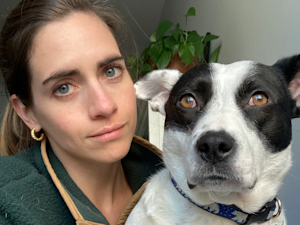
Sarah (Kollmorgen) Cottone
Sarah is a writer whose work has appeared in The Atlantic, Discover magazine, and HuffPost among other places. She lives outside of Denver with her husband and their dog, Lucy, who is the true queen of the household.
Related articles
![Woman wearing a magenta beret hat and a pink coat sitting on a wall outside and petting her black Labrador dog laying on the ground]()
How to Interpret Your Dog’s Facial Expressions and Behavior
Managing expectations about your dog’s behavior makes for a good relationship
Can Dogs Communicate With Each Other?
It’s about more than barking.
Why Does My Dog Stare at Me? Possible Reasons and What to Do
Beyond the fact that they’re your biggest admirer.
Why Does My Dog Sigh?
They truly act like the weight of the world is on their shoulders.
What Does It Mean When Your Dog Bows?
No, it’s not always about getting in a good stretch.
![Russian Toy Terrier with ears back]()
9 Reasons Why Dogs Put Their Ears Back
Here’s how your dog’s ears can clue you in to how they’re feeling.
